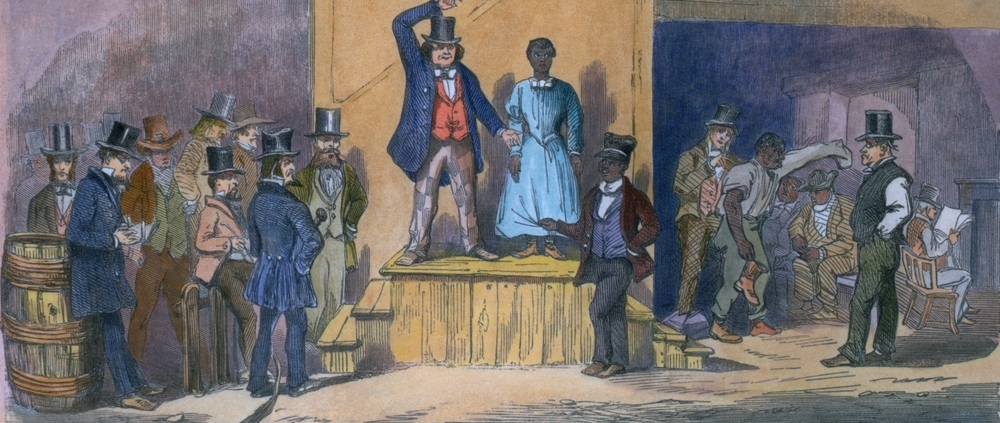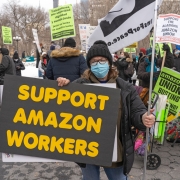The Origin of Black Friday: A Comprehensive Analysis of History, Controversy, and Consumerism
By Esther Claudette Gittens | Editorial credit: Everett Collection / shutterstock.com
Black Friday is widely recognized today as a day of shopping extravagance, marked by deep discounts and massive sales. However, the origins of Black Friday are far more complex and layered than the modern consumer-driven narrative. This article examines the history of Black Friday, its connections to slavery-era auctions, the evolution of its commercial significance, and the cultural implications of the day.
The Term “Black Friday” in Financial History
The earliest recorded use of the term “Black Friday” dates back to September 24, 1869, when a financial panic struck the United States. Two notorious speculators, Jay Gould and James Fisk, attempted to corner the gold market, causing the stock market to collapse and triggering widespread economic turmoil. This event was labeled “Black Friday” because of its devastating impact on businesses and the economy.
While this historical event is unrelated to shopping, it highlights the term’s association with hardship and crisis—a far cry from the celebratory consumerism of modern Black Friday.
Connections to Slavery and Exploitation
One of the most troubling and often overlooked aspects of Black Friday’s origins lies in its potential connection to the institution of slavery in the United States. During the 19th century, Fridays were commonly used as days for slave auctions, particularly after Thanksgiving. Slave traders would advertise and hold large auctions to sell enslaved individuals to plantation owners preparing for the upcoming agricultural season.
These events were horrific spectacles, with human beings treated as commodities. Scholars argue that the systemic exploitation during these auctions reflects a troubling parallel to the consumer frenzy and dehumanization often associated with modern Black Friday sales. While not a direct precursor to today’s Black Friday, the historical exploitation of labor and human dignity casts a shadow over the term’s history.
The Philadelphia Connection: A Modern Black Friday Emerges
The contemporary concept of Black Friday began in Philadelphia in the 1950s and 1960s. Police officers used the term to describe the chaos that erupted on the day after Thanksgiving. Throngs of suburban shoppers descended on the city, crowding streets, jamming traffic, and overwhelming stores. The same weekend also coincided with the Army-Navy football game, adding to the pandemonium.
For the police, it was a day of stress and frustration, earning the nickname “Black Friday.” Retailers initially resisted the term because of its negative connotations. However, by the 1980s, they successfully rebranded it as a day of profitability, shifting the narrative from chaos to commerce.
Black Friday and Consumer Culture
The transformation of Black Friday into a shopping holiday was fueled by a cultural and economic shift in the 20th century. Retailers seized on the day after Thanksgiving as an opportunity to kickstart the holiday shopping season. The myth that Black Friday marked the moment when stores went “from red to black” (operating at a profit) helped solidify its role in the retail calendar.
Psychological Triggers of Black Friday Sales
Retailers employ psychological tactics to drive sales and create urgency:
- Scarcity: Limited-time offers and doorbuster deals make consumers fear missing out.
- Competition: Crowded stores and long lines create social proof that reinforces the desirability of deals.
- Emotional Appeal: The promise of savings and the festive atmosphere encourage impulsive purchases.
These strategies turn Black Friday into a high-stakes event for shoppers, often leading to frenzied behavior and even physical altercations.
Cyber Monday and the Digital Shift
The rise of e-commerce in the early 2000s gave birth to Cyber Monday, the online counterpart to Black Friday. First coined in 2005 by the National Retail Federation, Cyber Monday capitalized on the growing trend of online shopping. It offered an alternative for consumers who wanted to avoid the chaos of brick-and-mortar stores
Today, the distinction between Black Friday and Cyber Monday has blurred. Many retailers offer week-long or month-long sales, reflecting a shift in consumer habits and technological advancements.
The Globalization of Black Friday
Although rooted in American traditions, Black Friday has become a global phenomenon. Countries like the UK, Canada, and Australia have adopted the event, often tailoring it to local customs. For instance:
- United Kingdom: Black Friday gained traction in 2010 when American retailers like Amazon introduced the concept to British consumers.
- China: While China has its own shopping holiday (Singles’ Day on November 11), Black Friday has made inroads among younger, Westernized consumers.
This globalization highlights the influence of American consumer culture and the universal appeal of discounted shopping.
Black Friday and Labor Dynamics
Black Friday raises significant questions about labor practices in the retail and e-commerce industries. Employees often face:
- Extended Hours: Many stores open as early as Thanksgiving evening, cutting into workers’ family time.
- Stressful Conditions: The influx of shoppers and heightened demands create challenging environments for retail workers.
- Low Wages: Despite the increased workload, many employees receive minimal compensation.
Labor activists and unions have criticized these practices, calling for better wages and working conditions, particularly for those who bear the brunt of Black Friday’s success
Criticisms of Overconsumption
Black Friday has also been criticized for promoting overconsumption and materialism. Environmental groups highlight the waste generated by mass production, packaging, and the disposal of short-lived goods. According to a Greenpeace report, the environmental impact of Black Friday includes significant carbon emissions and resource depletion.
Parallels Between Historical and Modern Exploitation
While today’s Black Friday sales differ from slavery-era practices, both are rooted in systems of exploitation. In the 19th century, enslaved individuals were dehumanized and sold as commodities. In modern times, low-wage workers and underprivileged communities often bear the brunt of the pressures created by consumerism.
Additionally, the frenzy of Black Friday often mirrors the dehumanizing aspects of historical auctions, with shoppers clamoring for goods in ways that reduce products—and sometimes people—to mere objects of desire.
Black Friday in the Post-Pandemic Era
The COVID-19 pandemic further accelerated the shift toward online shopping, transforming Black Friday into a hybrid event. Retailers now focus on:
- Omnichannel Experiences: Integrating in-store and online shopping to meet consumer needs.
- Personalization: Using data analytics to offer tailored deals.
- Sustainability: Some companies, such as Patagonia, have opted out of Black Friday altogether, promoting eco-friendly initiatives instead.
These trends reflect a growing awareness of consumer preferences and societal values, signaling a potential shift away from the excesses of traditional Black Friday.
Conclusion
The origins of Black Friday are steeped in a complex history of economic crises, societal exploitation, and cultural evolution. From its troubling ties to slavery-era auctions to its current status as a global shopping holiday, Black Friday has transformed over centuries, reflecting both the best and worst of human behavior.
While it remains a vital economic driver, Black Friday also prompts critical questions about labor rights, environmental sustainability, and the ethics of consumerism. As the day continues to evolve, its legacy will depend on how retailers, consumers, and society at large address these challenges.
Citations
- History.com Editors. (2022). What Is Black Friday and Why Is It Called That?. History.com. Retrieved from https://www.history.com
- Baptist, E. E. (2014). The Half Has Never Been Told: Slavery and the Making of American Capitalism. Basic Books.
- Mason, R. (2015). The Origins of Black Friday. Journal of American Retail History, 23(4), 45-60.
- Adobe Analytics. (2020). The Rise of Cyber Monday. Adobe Digital Insights. Retrieved from https://www.adobe.com
- Greenpeace. (2019). Black Friday’s Environmental Cost. Greenpeace Reports. Retrieved from https://www.greenpeace.org





Leave a Reply
Want to join the discussion?Feel free to contribute!